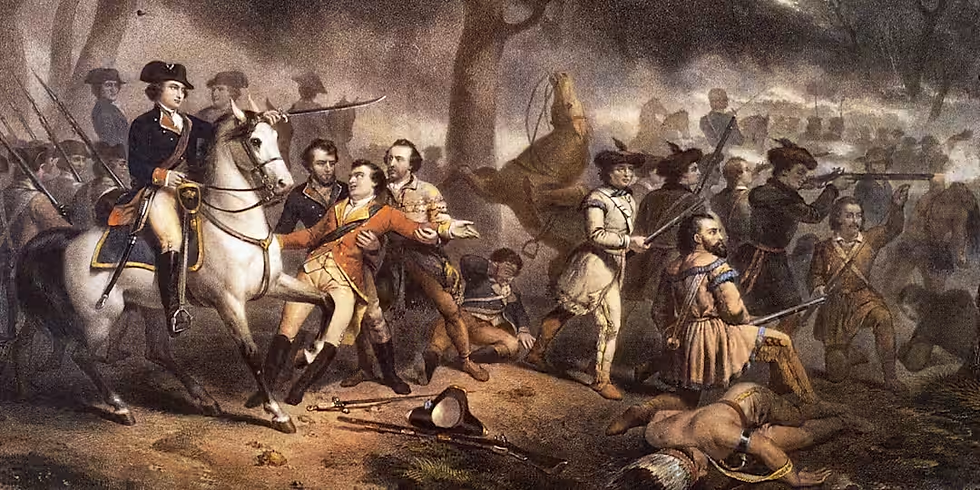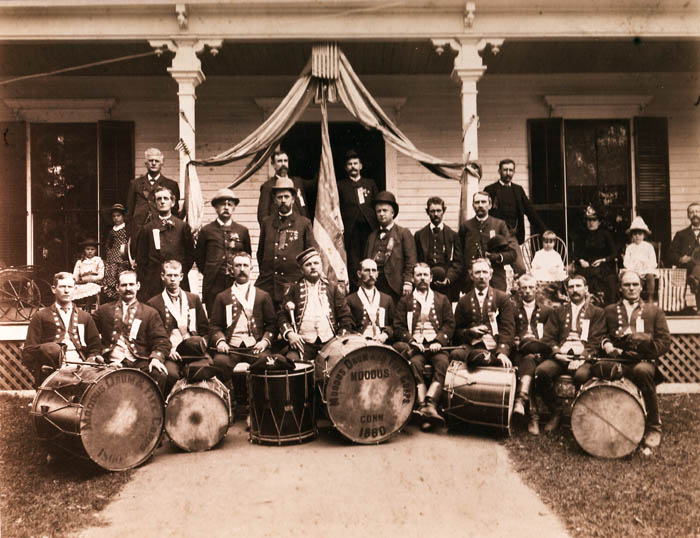Three Days of Celebration: Wilbraham’s 150th Anniversary, June 1913
- David Bourcier
- Nov 16
- 6 min read
Updated: Dec 11
Wilbraham’s 150th anniversary in June 1913 was remembered as one of the most remarkable events in the town’s history. For three days, June 17, 18, and 19, the normally quiet community swelled to twice its size as residents, former townspeople, and visitors from across the region gathered to honor the town’s incorporation in 1763. Every home was decorated, every organization contributed, and the entire community worked together to create an unforgettable celebration.
June 17 – Opening Day and Grand Parade
Wilbraham officially opened its three-day 150th anniversary celebration today, and the town truly “did herself proud.” Residents and visitors from across the region flocked to the town. From early morning until late afternoon, the streets were alive with the sights and sounds of one of the most impressive celebrations any New England town of its size had ever witnessed. Every member of the community, from children to elders, took part, reflecting the strong sense of pride and camaraderie that has long distinguished this small town nestled among the Wilbraham mountains.
The day began with the formation of a grand parade along Wilbraham Street (Main Street), which later extended to North Wilbraham and back. Leading the procession was Marshal J. M. Perry in his automobile, followed by the Brightside Band, a 31-piece ensemble whose lively music energized the crowds. Assistant marshals on horseback helped keep the floats spaced properly and ensured the parade ran smoothly.
Decorated automobiles carried the guests of honor, including former Senator W. Murray Crane, members of the town governments of Wilbraham and Hampden, and Springfield city officials. About twenty automobiles, adorned with colorful streamers and flowers, competed for prizes awarded to the most beautifully decorated vehicles. J. M. Perry’s car, with light blue streamers and wreaths of blue and white flowers, won the top prize, closely followed by Ernest Thompson’s pink and white display.

The historical division of the parade traced Wilbraham’s history, with floats illustrating key moments in the town’s development. Highlights included:
The Purchase of the Land from the Indians – A float with a wigwam, pines, and figures representing early settlers and the local Indian chief, guided by his daughter.
The First Settlers (1731) – Depicting a log cabin with a steaming pot, settlers returning from work, and children playing, showing life in early Wilbraham.
The Last of the Race – Honoring the Native American presence with a realistic portrayal of the squaw on Wigwam Hill, surrounded by period-appropriate artifacts.
The First Meeting House and Ministers – Floats recreating early religious life in Wilbraham, with parsons and congregants in historical dress.
Past and Present – Contrasting 17th-century crafts with modern 1913 industries, including a young Wilbraham Academy student courting a contemporary debutante.
The Minutemen of 1913 – Commemorating the town’s recent firefighting efforts to put out a forest fire that threatened the town in 1912, the Great Cedar Swamp Fire.


Additional floats celebrated local education, including Wilbraham Academy, and all public schools from Wilbraham and Hampden. Some floats depicted old home industries like shoemaking and cheese pressing, while others highlighted local agriculture and prize livestock. Business floats showcased local manufacturing, including jute processing, flour production, and fine paper, reflecting the town’s economic contributions.
At 12:30 p.m., around 500 guests dined in the Wilbraham Academy gymnasium, with Chairman C. C. Spellman presiding and honoring former Senator Crane, Springfield officials, and anniversary committee members. Afterward, attendees gathered at the Methodist Church for a program that included prayers, patriotic songs, and addresses by local and visiting dignitaries, including Alderman Henry Lasker, who represented Springfield, and William R. Sessions of Hampden. The historical committee presented a detailed address, recounting the town’s rich past and accomplishments.
Meanwhile, the loan exhibit at Grange Hall drew considerable attention. Visitors viewed a remarkable collection of historical artifacts, including communion sets from local churches, antique china, Indian relics, rare quilts and coverlets, early firearms, books, a copper-luster teapot from 1776, and items dating back more than two centuries. Rich Hall at Wilbraham Academy was also open for inspection, with visitors admiring recent improvements, including a new dining room, library, and dormitory spaces.
June 18 – Dedication of the Cutler Library
The second day of Wilbraham’s 150th anniversary celebration was held in North Wilbraham under ideal weather, drawing residents, former residents, and visitors from nearby towns, particularly Springfield. The day centered on the formal dedication and public opening of the Cutler Public Library, a handsome two-story building with a French roof, generously donated by the late Henry Cutler, one of Wilbraham’s most enterprising and public-spirited citizens. The library featured a reading room at the front and space for the town’s growing book collection in the rear.
Rev. William Lewis Jennings, pastor of Grace Union Church, presided over the opening at 11 a.m., introducing the aged Rev. Martin S. Howard, who offered a prayer of dedication. Mr. Jennings then presented the keys of the library to the trustees on behalf of the Cutler heirs, emphasizing the importance of public libraries as institutions that foster learning, community, and moral growth. Librarian Wilcox of the Holyoke City Library spoke on the lifelong benefits of libraries, predicting a bright future for North Wilbraham and noting that even larger towns were not as fortunate in having a dedicated library building. Miss Ida F. Farrar of the Springfield City Library brought greetings from her library and encouraged young people to make the most of the library’s resources. Rev. H. F. Legg praised Wilbraham as “the best town in the best state of the best country,” expressing confidence in the library’s role in shaping the community’s future.
Rev. Dr. William R. Newhall of Lynn delivered an address on “The Place of the Library in the Country Town,” praising the New England tradition of civic-minded citizens such as Henry Cutler. He emphasized that the library complemented other institutions—the school, church, town meeting, and home—and highlighted the enduring importance of the country town as a center of culture, learning, and civic responsibility. Dr. Newhall also traced the history of American libraries, noting Benjamin Franklin’s efforts to make knowledge accessible to all and stressing that the modern library is an institution of intelligence and opportunity.
At noon, about 200 guests enjoyed a dinner served by the Barr Catering Company under a large tent across from the library. In the afternoon, J. T. Bowne, a member of the Y. M. C. A. college faculty, delivered a lecture on “The Indians in and about Wilbraham.” Using relics collected mainly by B. F. Greene, Mr. Bowne illustrated the lives of Massachusetts Indians nearly 300 years ago, describing their villages, homes, utensils, clothing, and hospitality. He also recounted a journey undertaken by John Winthrop, Jr., in 1645, and described interactions between the Native inhabitants and early settlers.
Later in the day, the gardens of Mr. and Mrs. H. W. Cutler hosted a performance of the cantata The Flower Queen. Thirty young girls, dressed in bright costumes and carrying seasonal flowers, performed a pageant illustrating lessons of purity, unselfishness, and service to others. Esther Bell was crowned the May Queen, Verena Griswold portrayed a recluse learning these lessons, and Mrs. Alice Hoyt served as mistress of ceremonies. Children acted as flowers and fairies, creating a vibrant and festive atmosphere that delighted the large audience.
Throughout the day, visitors also explored a loan exhibition in the new library, which filled three rooms with historic artifacts. The exhibit included family heirlooms, antique furniture, early schoolbooks, woven coverlets, kitchen tools, guns, pikes carried by John Brown’s men, and an Indian-made buckskin coat. Contributions came from many residents, including the Warren family, G. M. Greene, Miss E. O. Beebe, and others. The display offered a vivid glimpse into Wilbraham’s past, illustrating both domestic life and historical events.
Hundreds of visitors attended the day’s events, many arriving by automobile as part of the Springfield Automobile Club’s annual outing. The Brightside Band provided music throughout the day, adding to the festive atmosphere. The dedication of the Cutler Public Library, the cantata, the lecture, and the historical exhibit together made the second day of Wilbraham’s 150th anniversary a memorable celebration of education, history, and community pride.
June 19 – Glendale’s Celebration and Closing Events
The final day of Wilbraham’s 150th anniversary celebration centered on Glendale, where a massive boulder was unveiled to honor the town’s war heroes. Civil War veterans raised the flags from the monument while schoolchildren sang and recited patriotic selections. Residents, former residents, and guests from Springfield attended, lending the event a warm “old home” atmosphere.

Speakers included William R. Sessions, who highlighted Wilbraham’s contributions to the Revolutionary War and the Civil War, noting the town’s significant participation and expenditures for war efforts. Dr. Marshall Calkins emphasized the importance of monuments in preserving the memory of those who served, reading the names of Glendale soldiers inscribed on the boulder. A short pageant depicted Wilbraham’s role in the Underground Railroad, with performers portraying escaped slaves aided and sheltered by Glendale residents.

Following the morning exercises, 200 guests enjoyed a lunch hosted by the women of Glendale. The afternoon featured speeches, poems, and letters from former residents.
Visitors then toured the Beebe Collection at the old Mixter Tavern, a remarkable exhibit of antiques, household items, and artifacts from 19th-century life in Wilbraham. The display included rare china, needlework, old almanacs, costumes, and unique curiosities, offering a vivid glimpse of early local life.
With nearly perfect weather and no incidents, the three-day celebration concluded successfully, leaving lasting memories for all who attended.




Comments